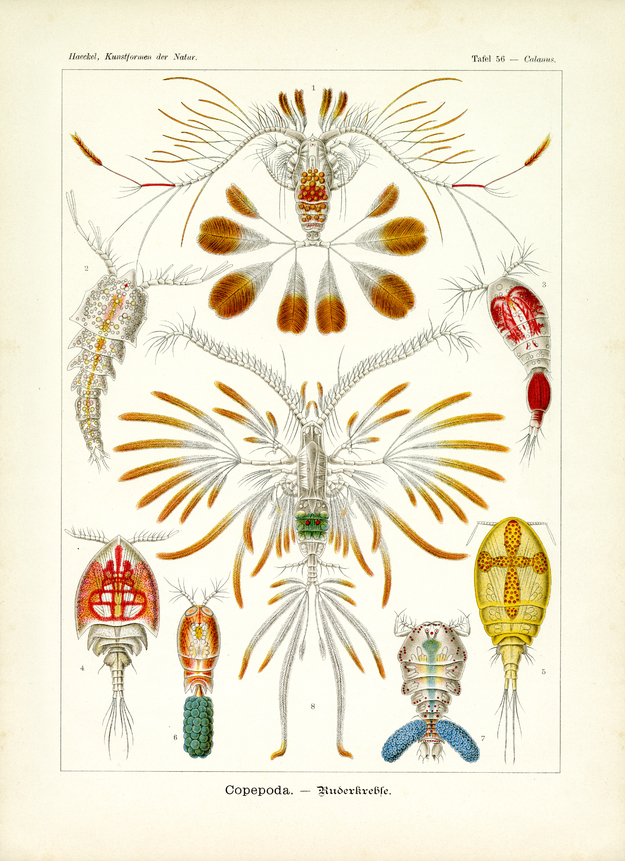Translation of the original German introduction by Ernst Haeckel:
The order of Copepoda constitutes a large, most diverse division within the group of lower crustaceans (Entomostraca); well over thousand species are known now. The large majority more than nine tenth) live in the sea, less than a tenth part in freshwater. About half of the species swim freely in water and feed on small animals; the other half got used to living like parasites, sitting firmly attached to fishes and other marine animals for most of their lives;
these parasites (so-called ‘water lice’) show all levels of regression and atrophy. Most copepods are of very small body size; only one or a few millimeter long; what they lack in this respect they balance with a monstrous fertility and fast mass development. The small copepods therefore are most important and most frequent components of plankton, i.e. the mass of small animals and plants that live close to the surface of a water body or at various levels of water depth, floating, not touching the ground. Many kinds of freely swimming copepods occur in such huge amounts that they cause a particular coloration of the water and form the principal food of bigger marine life, for example herring, mackerel and other fishes, bigger crustaceans, octopuses, medusae, etc. Numerous copepods are characterized by the delicate forms of their appendages, bright colouring of their chitin shell and a metallic shining. Legs and tail bristles are usually feathered or ornamented with delicate, colourful, feather-shaped appendages; pelagic animals use them as hovering apparatuses that prevent their receding in the water.
Just like insects on land Copepoda play a crucial role in water by adapting in most variable ways to various living conditions; like insects they always retain the same structure of their frame due to conservative inheritance (in spite of the greatest variety of particular body formation).
In most free living Copepoda the structured body consists of 15 segments or Metamera distributed evenly to the three main parts; initially, five segments belong to the most anterior part, the head, five to the intermediate, most broad part, the thorax; five to the posterior part, tail or abdomen. The head (Caput) carries two pairs of ‘sensing horns’ or antennae and three pairs of jaws, one pair each of upper jaw (Mandibulae), lower jaw (Maxillae), and ‘back jaw’ (Postmaxillae). Usually the head is grown on to the first ‘thoracic ring’ and is therefore called as ‘head breast’ (Cephalothorax). The five rings of the thorax carry five pairs of ‘oar feet’ that are double-branched and studded with long ‘swimming bristles’, usually in the shape of feathers (fig 1, 8). The five Metamera of the abdomen carry no limbs; the last part (Telson) ends in a ‘tail-fork’, to which long tail bristles are fixed. They may also have the form of delicate colourful feathers (fig. 1, 8). Females usually carry one pair of ‘egg-pouches’ at the base of the first abdominal segment (fig. 7). Males are most often smaller and more easily movable compared to the more sturdy females.
Translation by VR Translators Bangalore
We've scanned the original lithography at 1200dpi on the Epson A3 scanner of A3 scanner huren. You can download a 400dpi JPEG here.
